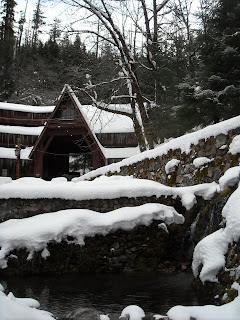It was pretty great - the first day was sunshine, and the next two or three were miserable rain. Other than packs and boots, we had no gear to speak of - just some vaguely rain-proof jackets from Goodwill, and jeans. ("Now girls, you might want some waterproof pants, too." "Those look dumb! It's not going to rain! Jeans are great for hiking!") We resorted to wearing ziplock bags around our multi-socked feet, and didn't get warm or dry for the whole trip.
Between the physical discomfort of hiking oh-so-immense distances (say, three miles) and the subversive thrill of eating meals out of pots and mugs, it was the Best Hike Ever.
We went on to repeat this for at least two more summers - though we eventually got some rain proof fpants. (Luckily, as one trip it rained for five straight days.)

(I'm on the left, my sister on the right. Check out that 1990s bucket hat! Upon closer inspection, that's also a tie die shirt.)
This series of miserable, fantastic hikes has acquired a certain hard-core nostalgia for my sister and I.
(A sea stack near Rialto Beach.)
After my classes were done this summer, and before my sister left for her first year at college, we decided to do it again - but this time, a longer distance at a faster pace. Our mother was quite concerned that we wouldn't be able to do it, and insisted we build in an extra day, and bring an extra day's food, in addition to our regular emergency supply.

(An annotated map.)
However, this time our dad was too busy at work to come with us. Being intrepid young ladies, we decided to go anyway. Also, we decided to start much farther South (at Rialto Beach,) and work our way North to more nostalgic environs.
Unfortunately, the tides during our chosen dates were very unfavorable: high tide was at mid-day. Our plan was to get up early, hike until lunch, have a seista, and then get started again.
As will be seen, the best laid plans of mice and young women hiking oft go astray.

When we picked up our permit at the NPS office, the vaguely good-lookin' fellow behind the counter felt obligated to consult with us about the tides.
NPS Fellow: "Counter-intuitively, the empty moon means a full moon, but a filled in moon means a new moon."
Me (in an attempt to be amusing): "And next Edward Cullen is going to show up."
(The NPS fellow got this strained look on his face.)
Sister: "Who?"
Me: "You know, that dude from the Twilight books... the second one's called New Moon... Ha ha?"
(The NPS fellow still looked pained, and finished with us quickly.)

Unfortunately, the tides during our chosen dates were very unfavorable: high tide was at mid-day. Our plan was to get up early, hike until lunch, have a seista, and then get started again.
As will be seen, the best laid plans of mice and young women hiking oft go astray.

(Lake Crescent)
The first day, we drove out, passing Lake Crescent. This is a gorgeous glacier carved lake, as you can see from the U-shape of this valley. There were packs of cyclists on the roads, and the lake looked perfect for kayaking. We really wanted to stop, but we were already late getting underway.When we picked up our permit at the NPS office, the vaguely good-lookin' fellow behind the counter felt obligated to consult with us about the tides.
NPS Fellow: "Counter-intuitively, the empty moon means a full moon, but a filled in moon means a new moon."
Me (in an attempt to be amusing): "And next Edward Cullen is going to show up."
(The NPS fellow got this strained look on his face.)
Sister: "Who?"
Me: "You know, that dude from the Twilight books... the second one's called New Moon... Ha ha?"
(The NPS fellow still looked pained, and finished with us quickly.)

(What the...?)
We drove out to the trailhead, and along the way, were confused to see a bunch of signs saying things like "Hungry? Stop in for a Bite!", "Bella eats here!", and "Treaty Line!"Turns out "Twilight" was shot over near Forks, WA, and the nearby areas have been simply mobbed with fans. Which would explain why the NPS fellow looked so horrified at a pair of young women talking about Edward Cullen.
Both my sister and I think "Twilight" is an abomination, so the Pacific Northwest was safe from any more fan-girl drool.

(The back of our minivan (with no seats) before packing. Yikes.)
As we got older, we started accumulating hiking stuff: fancy sleeping bags and thermal long-johns and whatnot. At the trailhead, we were confronted with the challenge of forcing all this gear AND the bear cans filled with food fit in our packs.Huh.
At least we didn't have any plates.


(Finished packing! Mine on the right, my sister's on the left.)
Eventually we managed to fit (most) everything - though it bears note that my sister's pack was much larger than mine. All throughout the hike, she was pulling out clean tee-shirts and extra, unneeded layers, whereas I only had one of everything.I made up for this by making her carry the tent and the stove.


(Right: Another sea stack. Left: Hole in the Wall)
The first day was one of the best. There was some great geology to be seen - awesome wind-carved sandstones, vertical layers of what appeared to be mudstones, and huge conglomerates. It was one of the cooler areas of sedimentary geology that I've seen. Unfortunately, being late and low on camera batteries, we didn't take pictures.
(The beach at Chilean Memorial.)
After about 3.7mi, we arrived at Chilean Memorial, a beach near the site of some old shipwreck far offshore, and a memorial somewhere in the woods. There were also some some campsites dug vaguely out of the bank.
All of which were unfortunately taken.
My sister and I ended up camping in the following spot:

All of which were unfortunately taken.
My sister and I ended up camping in the following spot:

(Ouch.)
Now, camping behind the log on top of some rocks was not our first choice. We had originally camped on the nice sandy spot in front of the log, but it looked a little close to the high tide mark...


(Our tent was in the sandy spot.)
And, as we found out at about 2am, it really was.
Luckily we woke up before the tide started creeping into our tent.
But it wasn't exactly pleasant to wake up at 2am, argue about which rocky bit to move the tent to, move the tent over the log, fight off the sand-fleas and moths drawn to the headlamps, and then crawl back into said tent. Where we then had to try get cozy on the rocks and fall asleep, all the while wondering if the tide was going to come into our new campsite.
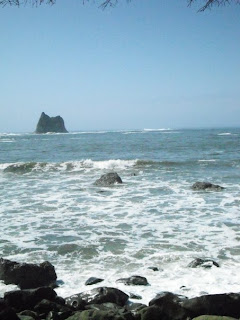
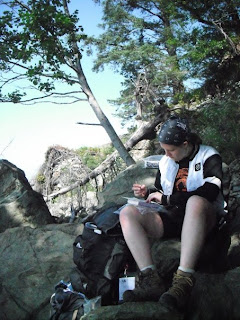
We climbed up on some rocks on the point of a little headland, made a little food, napped a bit, I read "Notes from Underground", my sister played sodoku.
(Like I said, we're not big fans of Twilight.)
After the tide had lowered a bit, we set out to finish the day's 4.7 miles.
We were rounding a small headland (marked with a red dot on the map,) the last before the next camp's beach, when calamity struck again.
It was getting dark, and the next high tide was threatening to arrive. My sister (in much better shape than I) was leading at a brisk pace over some large, slimy, algae covered rocks.
I stepped off a rock, and my right foot lost its footing. My top-heavy pack began to pull me backward. I fumbled with my right foot, trying to gain traction, turning myself in a 180 degree turn before my pack pushed me over and I started to fall, face forward, toward the pointy tip of a rock.
As my chest rushed toward the ground, the only thought going through my head was "I am going to die. The force of this blow will stop my heart, and I will die. This is it."
Luckily, when I hit the rock, only the wind was knocked out of me, not my life.
After I had recovered said breath, I lay there, pinned by my pack, in a lot of pain, and yelled (probably more like squealed, to be honest) for my sister.
She helped me up, and we surveyed the damage. No broken ribs, but some nasty bleeding contusions on my knees. We decided to finish getting around the headland, and then deal with the damage.
As we walked away, going much more slowly, I asked her: "So, when I fell, did I flail around? Or was I more like a sack of potatoes?"
"Well, kinda both. With a little twirl."
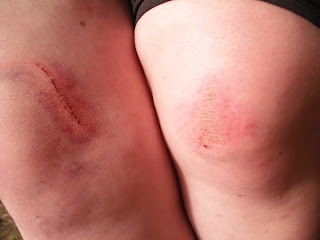
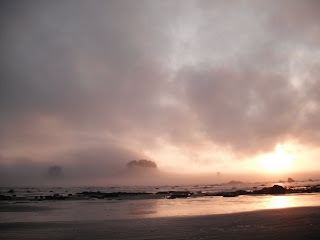
Luckily we woke up before the tide started creeping into our tent.
But it wasn't exactly pleasant to wake up at 2am, argue about which rocky bit to move the tent to, move the tent over the log, fight off the sand-fleas and moths drawn to the headlamps, and then crawl back into said tent. Where we then had to try get cozy on the rocks and fall asleep, all the while wondering if the tide was going to come into our new campsite.


(Right: The view from our rest spot. Left: My sister, doing the soduku.)
The next morning we awoke slightly sore and grumpy, and left camp a few hours later than anticipated. After rounding Cape Johnston, maybe a mile from camp, it was time to wait out the high tide.We climbed up on some rocks on the point of a little headland, made a little food, napped a bit, I read "Notes from Underground", my sister played sodoku.
(Like I said, we're not big fans of Twilight.)
After the tide had lowered a bit, we set out to finish the day's 4.7 miles.
We were rounding a small headland (marked with a red dot on the map,) the last before the next camp's beach, when calamity struck again.
It was getting dark, and the next high tide was threatening to arrive. My sister (in much better shape than I) was leading at a brisk pace over some large, slimy, algae covered rocks.
I stepped off a rock, and my right foot lost its footing. My top-heavy pack began to pull me backward. I fumbled with my right foot, trying to gain traction, turning myself in a 180 degree turn before my pack pushed me over and I started to fall, face forward, toward the pointy tip of a rock.
As my chest rushed toward the ground, the only thought going through my head was "I am going to die. The force of this blow will stop my heart, and I will die. This is it."
Luckily, when I hit the rock, only the wind was knocked out of me, not my life.
After I had recovered said breath, I lay there, pinned by my pack, in a lot of pain, and yelled (probably more like squealed, to be honest) for my sister.
She helped me up, and we surveyed the damage. No broken ribs, but some nasty bleeding contusions on my knees. We decided to finish getting around the headland, and then deal with the damage.
As we walked away, going much more slowly, I asked her: "So, when I fell, did I flail around? Or was I more like a sack of potatoes?"
"Well, kinda both. With a little twirl."

(This is nothing compared to how my sternum felt.)
I had bruises for a few weeks, and, several months later, still have scars on my knees. My sternum (where I hit the rock) never really bruised up, but it hurt to breathe for several weeks. It kinda sucked.
(It took us a few minutes to figure out what that was.)
It was all worth it soon, when we got to see these fantastic sea stacks rising out of the fog, backlit by the sunset.
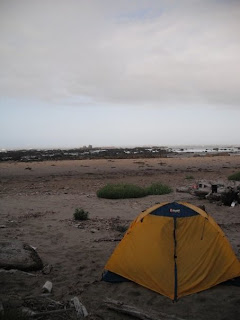

(Mmm...now this is more like it!)
Our campsite that night made up for it too: right on the beach, not too close to the waves, not too many sand fleas, and cheerful neighbors. Inland, in the forest, there's an actual campground (Cedar Creek Campground,) an old mine, and, some years, a seasonal ranger station. But the forest is creepy, the weather was nice, and the beach fantastic: so we camped there.
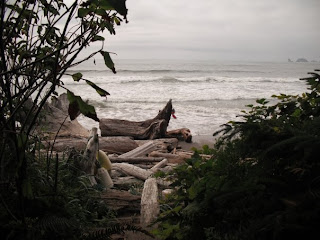
(You'd think it'd be impossible to get lost on a beach, but...)
The next day was crazy. We took way too long packing up camp, and so were frantically rushing to beat the tides to our next siesta spot - a place we'd been before, called Norwegian Memorial. It was a good campground, immediately before a long, hard stretch of rocky beach, followed by one of our favorite campgronds: Yellow Banks. Ahead of us, we spotted a group travelling at a pace just slightly faster than ours, and so we decided to follow them.
We booked around each and every headland, waiting to spot Norwegian Memorial, catching glimpses of the people ahead of us, worrying about the incoming tide the whole time. We didn't look at our watches, didn't stop to eat or rest or drink much water.
Eventually, the tide had risen so much that we were scrambling over the logs right next to the bank, covering our faces to escape the thick cloud of sandfleas that were frantically fleeing the tide themselves.
When we rounded that headland, we decided to give it a rest, even though we hadn't made Norwegian Memorial.

(We were so exhausted and hungry, we just chucked stuff about.)
We took the first campsite we saw, and dropped our packs in relief. We cooked some food, drank some water, and put our feet up for a bit.
Then we checked our watches, and realized that we'd hiked completely through the high tide. And this beach didn't really look like Norwegian Memorial, but it was the first campground we'd seen.
Huh. How odd.

(I can't say my shoelaces fared well on this venture.)
I walked down the beach, and found the group we'd been following around all the headlands.
"Excuse me, but do you know how far it is to Norwegian Memorial?" I asked.
"Oh, it's about four miles that way." they responded, pointing to the way we'd come.
"Oh. But, where are we?"
They looked at me like I had recently escaped from the psych ward.
"This is Yellow Banks. See?" They pointed to the other end of the beach. "The Yellow Bank?"
I stared at it.
Then I thanked them, and went back to my sister.

"Hey, come look at this." I said, and pointed down the beach. "What color would you say that bank is?"
"Um, I don't know - yellow?" she said. "Are we at Yellow Banks?!"

(My sister was very happy to stop walking!)
We were so excited to have hiked our day's allotment before lunch that we decided to just hike out that night. We were pretty impressed with ourselves.Cocky little brats.
Actually, we decided that, since there were only six miles left - three of them on the boardwalk - to hike out that night so my sister could have more time to get ready for her departure. We ended up booking through most of the spots we remembered, reached our car well after dark, and eventually had to stop and sleep in the car at a Park and Ride.

(I can't say my fashion sense has improved much since I was a child.)
It was a pretty great trip.
Even if I didn't collect any rocks, and Edward Cullen was no where to be seen.


